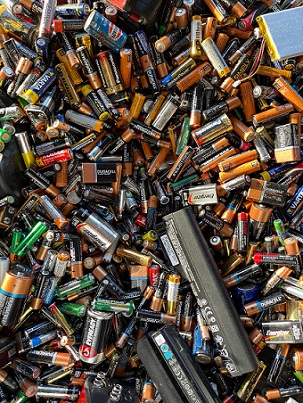 Are lithium batteries the new fire hazard for the 2020s?
Are lithium batteries the new fire hazard for the 2020s?
 All these everyday devices are powered by lithium-ion batteries
All these everyday devices are powered by lithium-ion batteries
 The last place you want a lithium battery fire is in the confined space of an aircraft
The last place you want a lithium battery fire is in the confined space of an aircraft
 An AvSax lithium battery fire mitigation bag
An AvSax lithium battery fire mitigation bag
 The AvSax lithium-ion battery fire mitigation bag won the Queen's Award for Enterprise
The AvSax lithium-ion battery fire mitigation bag won the Queen's Award for Enterprise
Each generation faces its own fire dangers but it seems lithium-ion batteries are fast becoming THE fire hazard for the 2020s.
Over the years we have seen firefighting campaigns targeting the fire risks of the time – open chip pans in the 1970s, foam-filled furniture in the 1980s, the lack of smoke detectors in homes in the 1990s and the risk of tumble dryers bursting into flames in the 2000s.
The problems behind these fire risks have been tackled by changing trends along with Government legislation but the issue that has crept up on us is recent years is the fire risk posed by lithium-ion batteries.
They are a vital part of all our daily lives and power just about everything we use from mobile phones, iPads, laptops, earphones and vapes to E-scooters and electric cars.
They are a fire risk but there is still uncertainty and difficulty over how to put them out once they catch fire.
The problem is not so much that they burn, more a case of how they burn. Batteries are made up of cells ranging from just two for tiny devices to up to 7,000 for cars and once one cell overheats and catches fire it quickly spreads to the next cell and then the next at such a phenomenally fast rate threat it can resemble an explosion. This is what’s called thermal runaway which is also known as 'venting with flame.'
With electric cars the emergency services are more inclined to let the fire burn out rather than tackle it as the heat is so intense the fire can flare up again even hours later. They can pour immense quantities of water on the vehicle to try to cool the battery pack but it won’t prevent the fire from igniting once more. Fire crews also need to wear full breathing equipment as electric car fires are highly toxic.
This is what Bedfordshire Fire and Rescue Service in the UK says about electric car fires: “The service has two main options, let the fire burn out or extinguish it. The obvious choice seems to be to extinguish the fire. However, many electric vehicle manufacturers actually advise for a controlled burn. This is where the fire services allow the vehicle to burn out while they focus on protecting the surrounding area.
“Once the fire has been successfully put out, the problem for the fire brigade is not over. Electric vehicle fires are known to reignite hours, days or even weeks after the initial event and they can do so many times.
“Not only does this pose a safety issue, but it also poses a legal issue. Recovery firms are increasingly concerned about dealing with electric vehicles.”
In Bedfordshire, a fire engine will even follow the recovery truck back to its yard in case the damaged vehicle on board catches fire again. It then needs to be stored well away from other vehicles in case it flares up again and the fire spreads.
Electric scooters and electric bikes are banned on all London transport after an e-scooter caught fire on a Tube train last year.
London Fire Brigade then gave an indication of the scale of the problem, tweeting last December: “Firefighters have tackled more than 50 fires involving e-scooters and e-bikes in London this year which is why we are supporting the Transport For London ban.”
Transport for London said there have been a number of similar fires that gave off toxic smoke and were caused by “defective lithium-ion batteries which ruptured without warning.”
It added: “TfL consider that if this was to happen again and fires occurred in an enclosed area like a Tube train or a bus there could be significant harm to both customers and staff as well as secondary injuries from customers trying to escape the area.”
Lithium batteries in small personal electronic devices can cause severe building fires, especially if, say, a laptop is left charging on a bed, overheats and catches fire. The fire quickly spreads to soft furnishings and a home can soon be destroyed.
The reasons it can happen include cheap batteries or chargers that don’t meet safety standards, if the device is left in searing heat or it is damaged in some way or perhaps even crushed. If a battery is overheating sometimes you can see the device starting to bulge out.
Thermal runaway not only causes intense heat burning up to 900°C (1652°F), but a battery on fire can give off several flammable toxic chemical gases including deadly carbon monoxide, sulphur dioxide and hydrogen chloride which can irritate the skin, eyes and nasal passages and could even be fatal.
The worst place this can happen is in the confines of a passenger plane flying at 30,000ft – but it can and does occur. This is why thousands of aircraft have AvSax lithium battery fire containment bags on board which won the top award any business can get, the Queen’s Award for Enterprise. AvSax (http://avsax.com/) are now on more than 15,373 aircraft operated by 80 airline companies worldwide.
They have been used 33 times to deal with emergencies since the start of 2017 and every time they have been deployed the aircraft has been able to complete its journey safely with no need to divert or make an emergency landing.
According to a report called Toxic Fluoride Gas Emissions From Lithium-Ion Battery Fires compiled by the Swedish State-owned Rise Research Institutes of Sweden: “While the fire itself and the heat it generates may be a serious threat in many situations, the risks associated with gas and smoke emissions from malfunctioning lithium-ion batteries may in some circumstances be a larger threat, especially in confined environments where people are present, such as in an aircraft, a submarine, a mine shaft or a spacecraft.”
This AvSax technology is now being considered by several other industries as a way for them to deal with lithium battery fires including recycling companies and researchers are considering it as an effective way to deal with car battery fires.
Lithium batteries spark more than 300 fires in recycling and waste plants in the UK every year causing millions of pounds worth of damage. Around half off all fires in waste centres are caused by batteries.
Although all batteries can be recycled, the recycling rate for them is only around 45% meaning 55% - that’s tens of millions of batteries – are being thrown into household waste, causing a potentially massive fire hazard.
Dead batteries thrown away with other waste and recycling - known as ‘zombie batteries’- are likely to be crushed or punctured once the waste is collected and processed.
This can cause them to catch fire or even explode and recycling plants are full of highly combustible material such as cardboard and paper so a small fire can quickly become a raging inferno. Even jostling them around on conveyor belts can be enough to set them off.
In the USA the number of fires caused by lithium batteries is astronomical.
In 2018 a Consumer Product Safety Commission report identified more than 25,000 battery-related fires and explosions involving more than 400 types of battery-powered products between 2012 and 2017.
The Environmental Protection Agency in the US identified 245 fires across 64 waste facilities in 28 states, all caused by lithium batteries, but stressed there would be many more as these were only ones which made the news.